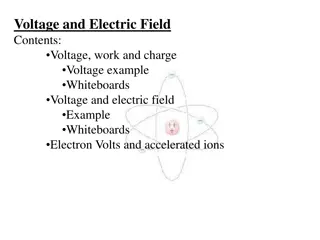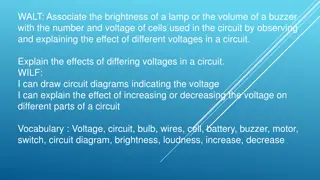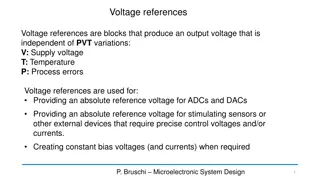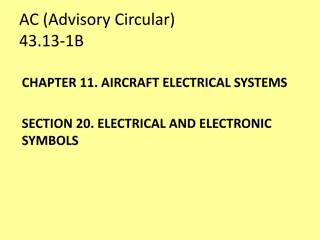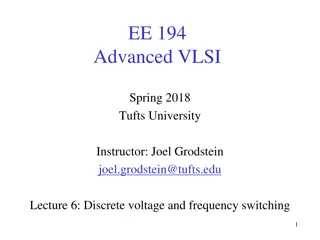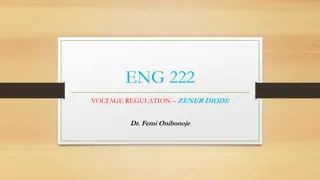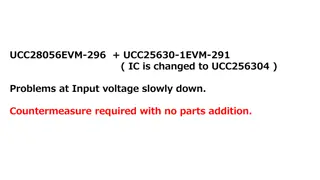Understanding Voltage Drop in Electrical Systems
Electrical calculations often focus on current or voltage drop to determine proper conductor sizes. Excessive voltage drop can lead to issues like flickering lights, poor heating, and overheating of motors, requiring attention to wire sizes and the National Electrical Code recommendations. Explore the principles of voltage drop, wire sizing, NEC guidelines, and practical examples to ensure efficient electrical design and performance.
Download Presentation

Please find below an Image/Link to download the presentation.
The content on the website is provided AS IS for your information and personal use only. It may not be sold, licensed, or shared on other websites without obtaining consent from the author. Download presentation by click this link. If you encounter any issues during the download, it is possible that the publisher has removed the file from their server.
E N D
Presentation Transcript
Voltage Drop Electrical Calculations Most building electrical calculations solve for current or voltage drop. Current sets conductor size. Excess voltage drop may require an increase in conductor size. 2
Voltage Drop AWG Conductor Sizes THHN Wire stands for - Thermoplastic High Heat-resistant Nylon coated. THHN is UL listed with a rated 90 degrees Celsius in dry locations or 75 degrees Celsius in wet applications with a THWN rating. 3
Voltage Drop Excessive Voltage Drop Excessive voltage drop in a circuit can cause: Lights to flicker or burn dimly Heaters to heat poorly Motors to run hotter than normal and burn out This condition causes the load to work harder with less voltage pushing the current. 4
Voltage Drop National Electrical Code (NEC) The National Electrical Code recommends limiting the voltage drop from the breaker box to the farthest outlet for power, heating, or lighting to 3 percent of the circuit voltage. This is done by selecting the right size of wire. 5
Voltage Drop National Electrical Code (NEC) Two Primary Electrical Design Concerns Current Required Voltage Drop 6
Voltage Drop National Electrical Code (NEC) Two Primary Electrical Design Concerns Current Required Voltage Drop 7
Voltage Drop IT Es 15 kW 120/240V 1 Total connected load for all the lights and equipment in the shop is 15 kW. 1 kW = 1,000 Watts 8
Voltage Drop #1 AWG #6 AWG 0.154 0.491 Table 310.15(B)(16) Table 8 9
Voltage Drop RLine RLine 120 V 1 There is a Voltage Drop (VD) due to the Conductor Resistance 10
Voltage Drop Kirchoff s Voltage Law 11
Voltage Drop Case 1: 120 V, 125 A, #1 Load Power 15kW Supply Voltage = 120 V Load Power = 15 kW Supply Current = 125 A Minimum Conductor Size = #1 RLine = (2 x 0.154 x L) / 1000 RLine ( ) Length (ft) VDLine (V) Vload (V) % VD 90 0.02772 3.465 117 2.89 120 0.03696 4.62 115 3.85 150 0.0462 5.775 114 4.81 230 0.07084 8.855 111 7.38 12
Voltage Drop Case 2: 120 V, 125 A, #1/0 Load Power 15kW Supply Voltage = 120 V Load Power = 15 kW Supply Current = 125 A Minimum Conductor Size = #1 #1/0 RLine = (2 x 0.122 x L) / 1000 RLine ( ) Length (ft) VDLine (V) VLoad (V) % VD 90 0.02196 2.745 117 2.29 120 0.02928 3.66 116 3.05 150 0.0366 4.575 115 3.81 230 0.05612 7.015 113 5.85 13
Voltage Drop Case 1: 120 V, 125 A , #1 Load Power 15kW RLine ( ) Length (ft) VDLine (V) VLoad (V) % VD 90 0.02772 3.465 117 2.89 120 0.03696 4.62 115 3.85 150 0.0462 5.775 114 4.81 230 0.07084 8.855 111 7.38 Case 2: 120 V, 125 A, #1/0 Load Power 15kW RLine ( ) Length (ft) VDLine (V) VLoad (V) % VD 90 0.02196 2.745 117 2.29 120 0.02928 3.66 116 3.05 150 0.0366 4.575 115 3.81 230 0.05612 7.015 113 5.85 14
Voltage Drop Case 3: 240 V, 62.5 A, #6 Load Power 15kW Supply Voltage = 240 V Load Power = 15 kW Supply Current = 62.5 A Minimum Conductor Size = #6 RLine = (2 x 0.491 x L) / 1000 RLine ( ) Length (ft) VDLine (V) VLoad (V) % VD 90 0.08838 5.52375 234 2.30 120 0.11784 7.365 233 3.07 150 0.1473 9.20625 231 3.84 230 0.22586 14.11625 226 5.88 15
Voltage Drop Example #2 A residential electric water heater is rated at 4.5 kW and operates at 208V (single phase wiring). 1. Determine the recommended Over Current Protection (OCP) (Circuit Breaker amperage rating) 2. Determine the copper wire size AWG based on NEC. 16
Voltage Drop Example #3 A current of 4 amps is flowing in a conductor that has a resistance of 2 per 1,000 feet. Find the voltage drop if the distance from the source to the load is 1,000 feet. + 4 amps Source - 17
Voltage Drop Example #3 A current of 4 amps is flowing in a conductor that has a resistance of 2 per 1,000 feet. Find the voltage drop if the distance from the source to the load is 1,000 feet. RLine= 2 + 4 amps RLine= 2 Source - Supply Current = 4 A RLine = 4 VD = 4 A x 4 = 16 V 18
Voltage Drop Example #4 An extension power cord made of CU #12 THWN is powering a lamp 300 feet from the source. The lamp resistance is 72 and the source voltage is 120 V. Find the voltage drop across the lamp. Rlamp = 72 I 120 V 19
Voltage Drop Example #4 An extension power cord made of CU #12 THWN is powering a lamp 300 feet from the source. The lamp resistance is 72 and the source voltage is 120 V. Find the voltage drop across the lamp. Rline = 1.98 Rlamp = 72 I 120 V Rline = 1.98 RLine = (2 x 1.98 x L) / 1000 = (2 x 1.98 x 300 ft) / 1000 = 1.188 I = 120 V / 73.188 = 1.64 A Elamp = 1.64 A x 72 = 118 V 20



